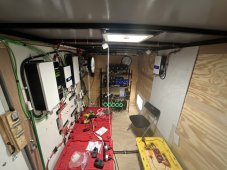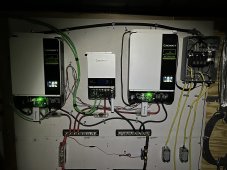MartyByrde
Off-Grid Innovator
Hello,
I have four LiFePo4 280Ah 16s’ in parallel on a busbar. I’ve been disappointed in how they’ve been performing - I thought I would get greater battery life. I thought fully charged I’d be able to run a 4000w load for at least 10-12 hours. It basically has been lasting about 3-5 hours. Usually it’s at 52.5v at sundown.
I decided to do some testing with the multimeter.
Tonight I am running a smaller 600W load. It shows 16.8 amps discharging from the battery. My wall outlet plug shows only 6.45 amps being discharged from the 120v plug.
Why is there such a big difference in the amps being used?
Does this mean I need to assume my batteries capacity is a fraction of what I thought?
Even just typing this message, the 600w load has drained all four from 51.5v to 51.2v in the course of 30 minutes. Not sure if this is normal with the discharge curve. I’d expected more capacity with four 16s batteries.
I have four LiFePo4 280Ah 16s’ in parallel on a busbar. I’ve been disappointed in how they’ve been performing - I thought I would get greater battery life. I thought fully charged I’d be able to run a 4000w load for at least 10-12 hours. It basically has been lasting about 3-5 hours. Usually it’s at 52.5v at sundown.
I decided to do some testing with the multimeter.
Tonight I am running a smaller 600W load. It shows 16.8 amps discharging from the battery. My wall outlet plug shows only 6.45 amps being discharged from the 120v plug.
Why is there such a big difference in the amps being used?
Does this mean I need to assume my batteries capacity is a fraction of what I thought?
Even just typing this message, the 600w load has drained all four from 51.5v to 51.2v in the course of 30 minutes. Not sure if this is normal with the discharge curve. I’d expected more capacity with four 16s batteries.





